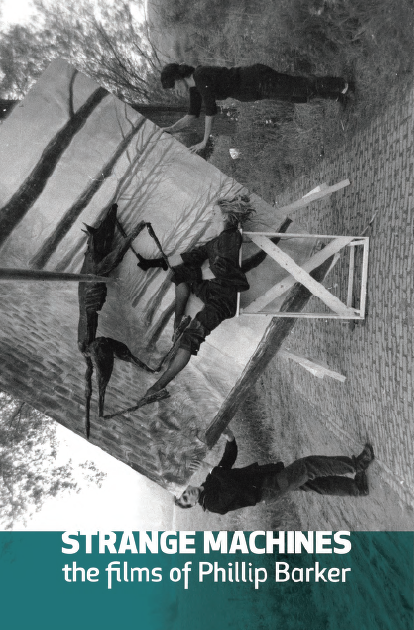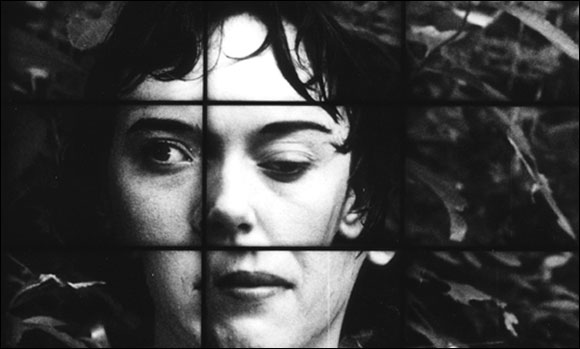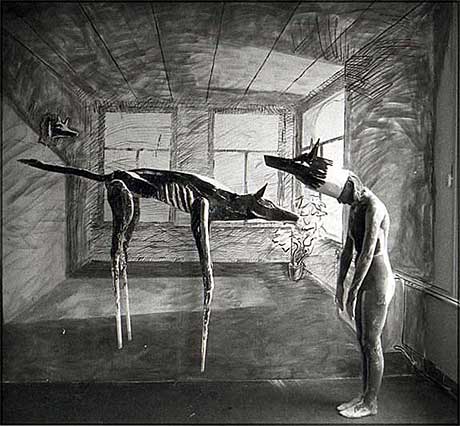Check out the beautiful volume, designed by Sean Scoffield
Published by Phillip Barker and Pleasure Dome in 2018.
Contents
Introduction by Mike Hoolboom
Search Lights: The Films of Phillip Barker by Tom McSorley
Soul Cages script
Origins: an interview with Phillip Barker
Magic Lanterns by Atom Egoyan
On Production Design by Phillip Barker
Movies: an interview with Phillip Barker
Machines
Films
I Am Always Connected by Yann Beauvais
A Temporary Arrangement by Jean Perret
Soul Cages by Laura Marks
Regarding by Dirk De Bruyn
Night Vision by Catherine Bush
Slow Blink by Erin Robinsong
Malody by Emily Vey Duke
Dredger by Helen Lee
Shadow Nettes by Greg Klymkiw
Filmography
Introduction
Do you believe in magicians?
When I met him he was staging Trust A Boat (1988), a strange and singular spectacle that lived for a moment in downtown Toronto, and across Holland. Phillip stuffed warehouse windows with projections that accumulated to form a single image, and alternated this with live silhouetted performers. There was a crazy amount of planning and production involved, yet the experience itself was not a hyper-controlled cine edict, but a wandering tapestry of needless beauty. Its public occupation asked fundamental questions about what this city could become, or what it meant to be a citizen, even as our industrial scape was converted into a giant aquarium of floating wonders.
Sometimes he would show me drawings of strange cinema delivery machines, construction cranes re-purposed to hoist mobile screens that moved slowly across fields while audiences followed. Or else giant lizard projectors vomiting pictures and sounds. Could the interface, the theatre itself, become a new machine that would make us strange enough to discover our roots again?
Even when his frames are filled with people (though never more than two or three) everyone looks like they are alone. His character avatars look lonelier in company, speaking in the remains of language, covered in industrial detritus, as if they had just crawled out of an excremental palace. They are survivors, though the nature of their trials and memories are only hinted at, suggested.
The girl-women who appear are invariably thin and white, as if adolescence had never let them go. They appear as apparitions, ghost studies, haunting diners and shipwrecks. They turn the world upside down. They are elemental, part of a natural world that appears as balm and threat. Sleepwalkers.
The artist’s mother floats down a river (is it the oldest fantasy — staging the death of our parents?), a troubled and withdrawn teen in a diner upends the scenery, a captain’s wife experiences a reverie of sexual awakening as soon as she’s able to forge a link to the forgotten history of her new home. The bond between past and present is also the mystery of aging and death. This is the secret that each of these women carry, and once they are lit up with the knowing, everything around them begins to turn, gravity cannot hold.
Anne Carson describes Echo as “the girl with no door on her mouth.”
How to say I love you to a machine? Perhaps we do it every day with our longed-for devices. How we love to tune in to the rhythms, re-form our bodies, open ourselves to the new framings required by our new and constant companions. But the cinema of Phillip Barker hearkens back to an earlier moment in our love affair with machines and a utopian science. Here are tools grown independent of their makers, no longer following the old laws, but instead offering a steady disordering and upending. A turning.
To say that there is a dream logic at work suggests that here is no logic at all, or that it is only a logic for one person. Imagine a car designed for a single trip. A building designed to be lived in for a single night. A meal that can be eaten once.
This eccentric and singular cinema has deep roots in the artist’s own experience. In this volume there are a pair of interviews, one dishes personal stories, while the other weighs in on his movies. He has worked a parallel practice all these years, designing handsome sets for his pal Atom Egoyan, so there’s a chapter where each weighs in on their collaborations. A brace of international talents sound off about his movies. He hasn’t made so many after all these years, because each one has to be lived and then drawn out in storyboards and then there is the money and unlikely technical demands, before the comrades of sound and editing and camera gather to convert the impossible into the inevitable.
There is a deep secret in his work though this book does not share it. Instead there are lists and exclamation marks. The grail of the imperfect. The most important things have been forgotten. Welcome to the magic of Phillip Barker.
Film and Installations
Films
I Am Always Connected 4:17 minutes Super 8 1984
A Temporary Arrangement 12:00 minutes 35mm 1995
Soul Cages 22:00 minutes 35mm 1999
Regarding 4:22 minutes 16mm 2002
Night Vision 19:30 minutes video and Super 8 2008
Appliance 6:00 minutes video 2009
Slow Blink 4:00 minutes Super 8 and Holga Stills on video 2010
Malody 12:10 minutes video 2012
Dredger 13.35 minutes video 2015
Shadow Nettes 17.25 minutes video 2017
Installations
Malody Revolution
2015, The Parkdale Film and Video Showcase, Toronto
A film loop of a revolving set of the interior of a diner was projected in a storefront window.
Adoration Street
2008, University of Toronto Football Field, Nuit Blanche, Toronto
An 80’ long photograph of a suburban street in Toronto, six rear-projected films on the windows.
A collaboration with director Atom Egoyan.
Critical Mass
2004, 64 Steps Contemporary Art, Toronto
Film rear projected in a gallery storefront. A larger-than-life woman scrutinizes and tracks the progress of people passing by the window.
5 Souls Released From Fetters
1998, Musee Regional de Rimouski, Quebec
Five 16mm film loops projected from the windows of a church situated on the banks of the St. Lawrence River. Backwards footage of various people as they are submerged in water.
We Floated Down River Street
1996, Dunlop Art Gallery, Regina and Mediatrics, Cold City Gallery, Toronto
Images of floating bodies were projected on a model of a building while a cello played notes through an underwater speaker.
Trial By Water
1992, EXPO ‘92, Seville, Spain
Video installation critical of Canada’s environmental protection policy played on the walls of a flooded camping tent within the Canada Pavilion’s reflecting pool.
Campos Magneticos
1991 ARCO International Art Fair, Madrid, Spain
A man, a woman, a bicycle and an accordion were suspended by wires on a 40’ outdoor film screen in a parking lot, with a live band playing original compositions.
Magnetic Fields
1989 Gallery 76, Toronto
Ten performers, including a trapeze artist, a mountain climber and an accordion player were suspended on a 40’ vertical screen stretched over a three-story Victorian house. The performers ‘inhabited’ painted landscapes that were projected from across the street.
Trust A Boat
1986 Amsterdam, Utrecht, Groningen, (Holland), Toronto, Peterborough, (Canada)
Original 35mm footage was optically printed onto nine strips of 16mm film which were run on nine 16mm projectors rear projected onto into nine windows. A composite dreamscape. In between reels nine shadow performers realize everyday gestures.


